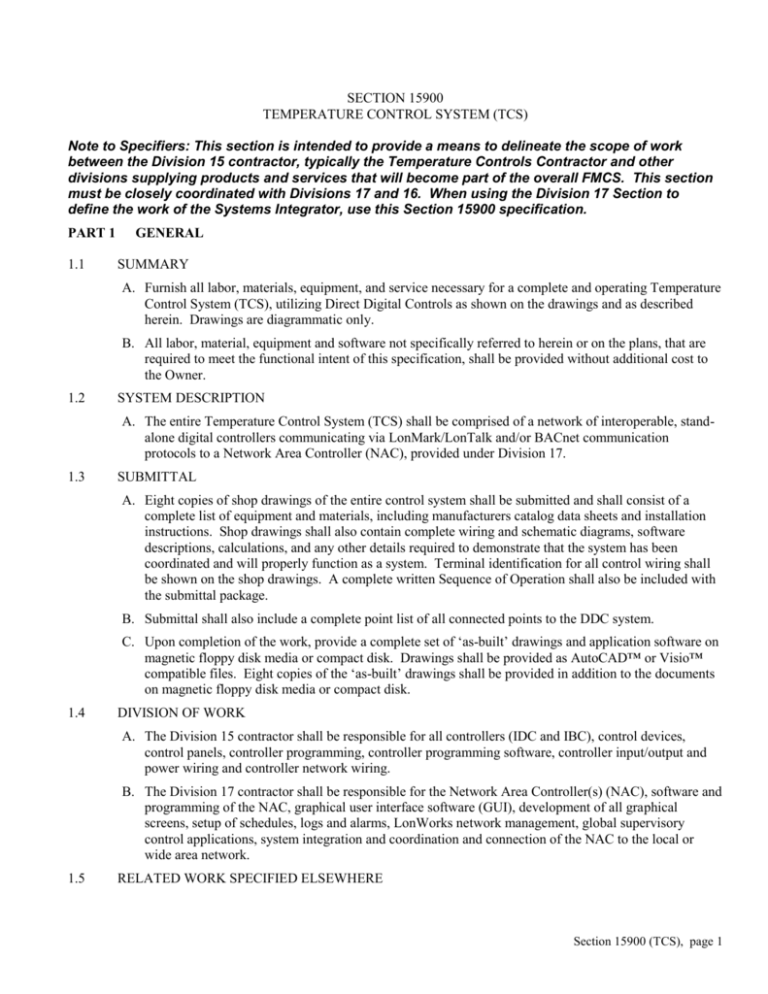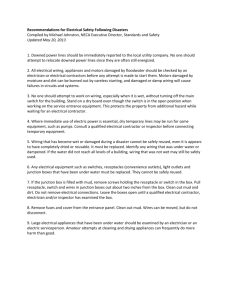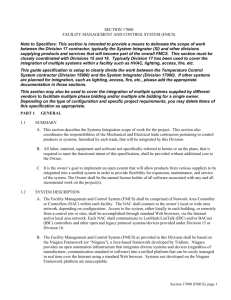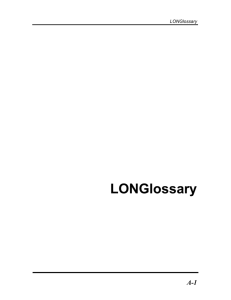NiagaraDivision17GuideSpec
advertisement

SECTION 15900 TEMPERATURE CONTROL SYSTEM (TCS) Note to Specifiers: This section is intended to provide a means to delineate the scope of work between the Division 15 contractor, typically the Temperature Controls Contractor and other divisions supplying products and services that will become part of the overall FMCS. This section must be closely coordinated with Divisions 17 and 16. When using the Division 17 Section to define the work of the Systems Integrator, use this Section 15900 specification. PART 1 1.1 GENERAL SUMMARY A. Furnish all labor, materials, equipment, and service necessary for a complete and operating Temperature Control System (TCS), utilizing Direct Digital Controls as shown on the drawings and as described herein. Drawings are diagrammatic only. B. All labor, material, equipment and software not specifically referred to herein or on the plans, that are required to meet the functional intent of this specification, shall be provided without additional cost to the Owner. 1.2 SYSTEM DESCRIPTION A. The entire Temperature Control System (TCS) shall be comprised of a network of interoperable, standalone digital controllers communicating via LonMark/LonTalk and/or BACnet communication protocols to a Network Area Controller (NAC), provided under Division 17. 1.3 SUBMITTAL A. Eight copies of shop drawings of the entire control system shall be submitted and shall consist of a complete list of equipment and materials, including manufacturers catalog data sheets and installation instructions. Shop drawings shall also contain complete wiring and schematic diagrams, software descriptions, calculations, and any other details required to demonstrate that the system has been coordinated and will properly function as a system. Terminal identification for all control wiring shall be shown on the shop drawings. A complete written Sequence of Operation shall also be included with the submittal package. B. Submittal shall also include a complete point list of all connected points to the DDC system. C. Upon completion of the work, provide a complete set of ‘as-built’ drawings and application software on magnetic floppy disk media or compact disk. Drawings shall be provided as AutoCAD™ or Visio™ compatible files. Eight copies of the ‘as-built’ drawings shall be provided in addition to the documents on magnetic floppy disk media or compact disk. 1.4 DIVISION OF WORK A. The Division 15 contractor shall be responsible for all controllers (IDC and IBC), control devices, control panels, controller programming, controller programming software, controller input/output and power wiring and controller network wiring. B. The Division 17 contractor shall be responsible for the Network Area Controller(s) (NAC), software and programming of the NAC, graphical user interface software (GUI), development of all graphical screens, setup of schedules, logs and alarms, LonWorks network management, global supervisory control applications, system integration and coordination and connection of the NAC to the local or wide area network. 1.5 RELATED WORK SPECIFIED ELSEWHERE Section 15900 (TCS), page 1 A. Division 17, System Integration: 1. Providing Network Area Controllers, connection to local or wide area network. 2. LonWorks network management 3. Integration of LonWorks and BACnet devices 4. Graphical user interface software 5. Global supervisory control sequences 6. Integration of owner’s existing control system B. Division 16, Electrical: 1.6 1. Providing motor starters and disconnect switches (unless otherwise noted). 2. Power wiring and conduit (unless otherwise noted). 3. Provision, installation and wiring of smoke detectors (unless otherwise noted). AGENCY AND CODE APPROVALS A. All products of the FMCS shall be provided with the following agency approvals. Verification that the approvals exist for all submitted products shall be provided with the submittal package. Systems or products not currently offering the following approvals are not acceptable. 1.7 1. UL-916; Energy Management Systems 2. ULC; UL - Canadian Standards Association 3. FCC, Part 15, Subpart J, Class A Computing Devices SOFTWARE LICENSE AGREEMENT A. The Owner shall sign a copy of the manufacturer's standard software and firmware licensing agreement as a condition of this contract. Such license shall grant use of all programs and application software to Owner as defined by the manufacturer's license agreement, but shall protect manufacturer's rights to disclosure of trade secrets contained within such software. 1.8 DELIVERY, STORAGE AND HANDLING A. Provide factory-shipping cartons for each piece of equipment and control device. Maintain cartons through shipping, storage, and handling as required to prevent equipment damage. Store equipment and materials inside and protected from weather. 1.9 JOB CONDITIONS A. Cooperation with Other Trades: Coordinate the Work of this section with that of other sections to insure that the Work will be carried out in an orderly fashion. It shall be this Contractor's responsibility to check the Contract Documents for possible conflicts between his Work and that of other crafts in equipment location, pipe, duct and conduit runs, electrical outlets and fixtures, air diffusers, and structural and architectural features. 1.10 QUALITY ASSURANCE A. The manufacturer of the TCS digital controllers shall provide documentation supporting compliance with ISO-9001 (Model for Quality Assurance in Design/Development, Production, Installation and Servicing). Product literature provided by the TCS digital controller manufacturer shall contain the ISO9001 Certification Mark from the applicable registrar. B. All components and systems shall be year 2000 (Y2K) compliant. Section 15900 (TCS), page 2 1.11 SPECIFICATION NOMENCLATURE A. Acronyms used in this specification are as follows: FMCS Facility Management and Control System TCS Temperature Control System NAC Network Area Controller IDC Interoperable Digital Controller IBC Interoperable BACnet Controller GUI Graphical User Interface WBI Web Browser Interface POT Portable Operator’s Terminal PMI Power Measurement Interface DDC Direct Digital Controls LAN Local Area Network WAN Wide Area Network OOT Object Oriented Technology PICS Product Interoperability Compliance Statement PART 2 2.1 MATERIALS GENERAL A. The Temperature Control System (TCS) shall be comprised of a network of interoperable, stand-alone digital controllers and other devices as specified herein. All controllers and software within the TCS shall be Year 2000 compliant and shall be supported by compliance documentation from the manufacturer. 2.2 OPEN, INTEROPERABLE, INTEGRATED ARCHITECTURES A. The intent of this specification is to provide a peer-to-peer networked, stand-alone, distributed control system with the capability to integrate both the ANSI/ASHRAE Standard 135-1995 BACnet and LonWorks technology communication protocols. Note to specifiers: Direct Digital Controllers conforming to either the LonMark interoperability specification, or the BACnet, ANSI/ASHRAE Standard 135-1995 specification may be used. For projects where only LonMark devices are required, use Item 2.3. Where only BACnet devices are required, use Item 2.4. For projects where it is required to use both LonMark and BACnet devices, uses Items 2.3 and 2.4. 2.3 INTEROPERABLE DIGITAL CONTROLLER (IDC) A. Controls shall be microprocessor based Interoperable LonMark or LonWorks Controllers (IDC). Where possible, all Interoperable Digital Controllers shall bear the applicable LonMark interoperability logo on each product delivered. B. HVAC control shall be accomplished using LonMark based devices where the application has a LonMark profile defined. Where LonMark devices are not available for a particular application, devices based on LonWorks shall be acceptable. For each LonWorks device that does not have LonMark certification, the device supplier must provide an XIF file for the device to the Division 17 contractor. Publicly available specifications for the Applications Programming Interface (API) must be provided to the Division 17 contractor for each LonWorks / LonMark controller defining the programming or setup of each device. The Division 15 contractor shall provide all programming, documentation and Section 15900 (TCS), page 3 programming tools necessary to set up and configure the supplied devices per the specified sequences of operation. C. The Division 15 contractor shall run the LonWorks network trunk to the nearest Network Area Controller (NAC). Coordinate locations of the NAC with the Division 17 contractor to ensure that maximum network wiring distances, as specified by the LonWorks wiring guidelines, are not exceeded. A maximum of 126 devices may occupy any one LonWorks trunk and must be installed using the appropriate trunk termination device. All LonWorks and LonMark devices must be supplied using FTT-10A LonWorks communications transceivers. D. The Network Area Controller (NAC), supplied by the Division 17 contractor, will provide all scheduling, alarming, trending, and network management for the LonMark / LonWorks based devices. E. The IDCs shall communicate with the NAC at a baud rate of not less than 78.8K baud. The IDC shall provide LED indication of communication and controller performance to the technician, without cover removal. F. All IDCs shall be fully application programmable and shall at all times maintain their LONMARK certification, if so certified. Controllers offering application selection only (non-programmable), require a 10% spare point capacity to be provided for all applications. All control sequences within or programmed into the IDC shall be stored in non-volatile memory, which is not dependent upon the presence of a battery, to be retained. G. The Division 15 contractor supplying the IDC’s shall provide documentation for each device, with the following information at a minimum: 1. Network Variable Inputs (nvi’s); name and type 2. Network Variable Outputs (nvo’s); name and type 3. Network configuration parameters (nci, nco); name and type H. It is the responsibility of the Division 15 contractor to ensure that the proper Network Variable Inputs and Outputs (nvi and nvo) are provided in each IDC, as required by the point charts. I. 2.4 The supplier of any programmable IDC shall provide one copy of the manufacturer’s programming tool, with documentation, to the owner. INTEROPERABLE BACnet CONTROLLER (IBC) A. Controls shall be microprocessor based Interoperable BACnet Controllers (IBC) in accordance with the ANSI/ASHRAE Standard 135-1995. IBCs shall be provided for Unit Ventilators, Fan Coils, Heat Pumps, Variable Air Volume (VAV) Terminals and other applications as shown on the drawings. The application control program shall be resident within the same enclosure as the input/output circuitry, which translates the sensor signals. The system supplier must provide a PICS document showing the installed systems compliance level to the ANSI/ASHRAE Standard 135-1995, to the Division 17 contractor. B. The IBCs shall communicate with the NAC via an Ethernet connection at a baud rate of not less than 10 Mbps or via the RS485 connection at a baud rate of not less than 38 kbps. C. The IBC Sensor shall connect directly to the IBC and shall not utilize any of the I/O points of the controller. The IBC Sensor shall provide a two-wire connection to the controller that is polarity and wire type insensitive. The IBC Sensor shall provide a communications jack for connection to the BACnet communication trunk to which the IBC controller is connected. The IBC Sensor, the connected controller, and all other devices on the BACnet bus shall be accessible by the POT. D. All IBCs shall be fully application programmable and shall at all times maintain their BACnet Level 3 compliance. Controllers offering application selection only (non-programmable), require a 10% spare Section 15900 (TCS), page 4 point capacity to be provided for all applications. All control sequences within or programmed into the IBC shall be stored in non-volatile memory, which is not dependent upon the presence of a battery, to be retained. E. The Division 15 contractor supplying the IBC’s shall provide documentation for each device, with the following information at a minimum: 1. BACnet Device; MAC address, name, type and instance number 2. BACnet Objects; name, type and instance number F. It is the responsibility of the Division 15 contractor to ensure that the proper BACnet objects are provided in each IBC, as required by the point charts. Note to specifiers: Specifications for other control system devices, sensors, actuators, etc. can be inserted here. Use the appropriate paragraph(s) as they pertain to the project requirements. 2.5 OTHER CONTROL SYSTEM HARDWARE A. Temperature Control Air Compressor (when required): A duplex air compressor system (two compressors mounted on one tank) shall be furnished and installed by the temperature control contractor. Air compressor system shall be sized to fit the pneumatic control system, to insure no more than 33% run time. The tank shall be sized for a maximum of 6 starts per hour. An automatic alternator shall be connected to the motors and pressure switches, in a 'lead-lag' manner, and shall alternate compressor operation after each on-off cycle. Alternator shall be further connected to energize the 'lag' operation after each on-off cycle. Alternator shall be further connected to energize the 'lag' compressor at the setting of the lower pressure switch if the "lead" compressor fails or is disabled for service. Air compressor system shall include a refrigerated air dryer sized for the capacity of the air compressor. Accessories such as filters, pressure regulators, valves, spring isolators, automatic tank drain etc. shall also be furnished for a complete operating system. B. Motorized Control Dampers (where furnished by the Temperature Control sub-contractor): Dampers shall be black enamel finish or galvanized, with nylon bearings. Blade edge and tip seals shall be included for all dampers. Blades shall be 16-gauge minimum and 6 inches wide maximum and frame shall be of welded channel iron. Dampers with both dimensions less than 18 inches may have strap iron frames. C. Control Damper Actuators (where furnished by the Temperature Control sub-contractor): Two-position or proportional electric actuators shall be direct-mount type sized to provide a minimum of 5 in-lb torque per square foot of damper area. Damper actuators shall be spring return type. Provide one actuator per damper minimum. Pneumatic actuators shall be sized to provide a minimum of 5 in-lb torque per square foot of damper area and shall include positive positioning pneumatic relays when sequenced with other actuators or when control action is to be proportional. D. Control Valves: Control valves shall be 2-way or 3-way pattern as shown constructed for tight shutoff and shall operate satisfactorily against system pressures and differentials. Two-position valves shall be ‘line’ size. Proportional control valves shall be sized for a maximum pressure drop of 5.0 psi at rated flow (except as may be noted on the drawings). Valves with sizes up to and including 2 inches shall be “screwed” configuration and 2-1/2 inch and larger valves shall be “flanged” configuration. Electrically controlled valves shall include spring return type actuators sized for tight shut-off against system pressures and furnished with integral switches for indication of valve position (open-closed). Pneumatically actuators for valves, when utilized, shall be sized for tight shut-off against system pressures. Three-way butterfly valves, when utilized, shall include a separate actuator for each butterfly segment. Section 15900 (TCS), page 5 E. Wall Mount Room Thermostats: Each room thermostat shall provide temperature indication to the digital controller, provide the capability for a software-limited set point adjustment and operation override capability. An integral LCD shall annunciate current room temperature and set point as well as override status indication. In addition, the thermostat shall include a port for connection of the portable operator’s terminal described elsewhere in this specification. F. Duct Mount, Pipe Mount and Outside Air Temperature Sensors: 10,000-ohm thermistor temperature sensors with an accuracy of ± 0.2ºC. Outside air sensors shall include an integral sun shield. G. Current Sensitive Switches: Solid state, split core current switch that operates when the current level (sensed by the internal current transformer) exceeds the adjustable trip point. Current switch to include an integral LED for indication of trip condition and a current level below trip set point. H. Power Monitoring Interface: The Power Measurement Interface (PMI) device shall include the appropriate current and potential (voltage) transformers. The PMI shall be certified under UL-3111. The PMI shall perform continuous true RMS measurement based on 32 samples-per-cycle sampling on all voltage and current signals. The PMI shall provide outputs to the FMCS based on the measurement and calculation of the following parameters: (a) current for each phase and average of all three phases, (b) kW for each phase and total of all three phases, (c) power factor for each phase and all three phases, (d) percent voltage unbalance and (e) percent current unbalance. These output values shall be hardwired inputs to the FMCS or shall be communicated to the FMCS over the open-protocol LAN. I. Water Flow Meters (when required): Water flow meters shall be axial turbine style flow meters which translate liquid motion into electronic output signals proportional to the flow sensed. Flow sensing turbine rotors shall be non-metallic and not impaired by magnetic drag. Flow meters shall be ‘insertion’ type complete with ‘hot-tap’ isolation valves to enable sensor removal without water supply system shutdown. Accuracy shall be ±2% of actual reading from 0.4 to 20 feet per second flow velocities. J. Temperature Control Panels: Furnish temperature control panels of code gauge steel with locking doors for mounting all devices as shown. Control panels shall meet all requirements of Title 24, California Administrative Code. All electrical devices within a control panel shall be factory wired. All external wiring shall be connected to terminal strips mounted within the panel. Provide engraved phenolic nameplates identifying all devices mounted on the face of control panels. A complete set of ‘as-built’ control drawings (relating to the controls within that panel) shall be furnished within each control panel. Note to specifiers: Specifications for project execution can be inserted here. Items covered should include installation, training, documentation, warranty, acceptance testing and, if desired, system commissioning. PART 3 3.1 EXECUTION INSTALLATION A. All work described in this section shall be installed, wired, circuit tested and calibrated by factory certified technicians qualified for this work and in the regular employment of the temperature control system manufacturer or its exclusive factory authorized installing contracting field office (representative). The installing office shall have a minimum of five years of installation experience with the manufacturer and shall provide documentation in submittal package verifying longevity of the installing company's relationship with the manufacturer. Supervision, calibration and checkout of the system shall be by the employees of the local exclusive factory authorized temperature control contracting field office (branch or representative). B. Install system and materials in accordance with manufacturer’s instructions, and as detailed on the project drawing set. Section 15900 (TCS), page 6 C. Drawings of temperature control systems are diagrammatic only and any apparatus not shown, such as relays, accessories, etc., but required to make the system operative to the complete satisfaction of the Architect shall be furnished and installed without additional cost. D. Line and low voltage electrical connections to control equipment shown specified or shown on the control diagrams shall be furnished and installed by the Division 15 contractor in accordance with these specifications. E. Equipment furnished by the HVAC Contractor that is normally wired before installation shall be furnished completely wired. Control wiring normally performed in the field will be furnished and installed by the Division 15 contractor. F. All control devices mounted on the face of control panels shall be clearly identified as to function and system served with permanently engraved phenolic labels. 3.2 WIRING A. All electrical control wiring and power wiring to the control panels shall be the responsibility of the Division 15 contractor. B. The electrical contractor (Div. 16) shall furnish all power wiring to electrical starters and motors. C. All wiring shall be in accordance with the Project Electrical Specifications (Division 16), the National Electrical Code and any applicable local codes. All TCS wiring shall be installed in the conduit types specified in the Project Electrical Specifications (Division 16) unless otherwise allowed by the National Electrical Code or applicable local codes. Where TCS plenum rated cable wiring is allowed it shall be run parallel to or at right angles to the structure, properly supported and installed in a neat and workmanlike manner. 3.3 WARRANTY A. Equipment, materials and workmanship incorporated into the work shall be warranted for a period of one year from the time of system acceptance. B. Within this period, upon notice by the Owner, any defects in the work provided under this section due to faulty materials, methods of installation or workmanship shall be promptly (within 48 hours after receipt of notice) repaired or replaced by the Division 15 contractor at no expense to the Owner 3.4 WARRANTY ACCESS A. The Owner shall grant to the Division 15 contractor, reasonable access to the TCS during the warranty period. 3.5 ACCEPTANCE TESTING A. The Division 15 contractor shall perform all necessary calibration, testing and de-bugging and perform all required operational checks to insure that the system is functioning in full accordance with these specifications. The Division 15 and 17 contractors are to coordinate the checkout of the system such that each Division has a representative present during system checkout. B. The Division 15 contractor shall perform tests to verify proper performance of components, routines, and points. Repeat tests until proper performance results. This testing shall include a point-by-point log to validate 100% of the input and output points of the DDC system operation. The Division 17 contractor shall have a representative present during system checkout by the Division 15 contractor. C. Upon completion of the performance tests described above, repeat these tests, point by point as described in the validation log above in presence of Owner's Representative, as required. Properly schedule these tests so testing is complete at a time directed by the Owner's Representative. Do not delay tests so as to prevent delay of occupancy permits or building occupancy. Section 15900 (TCS), page 7 D. System Acceptance: Satisfactory completion is when the Temperature Control sub-contractor has performed successfully all the required testing to show performance compliance with the requirements of the Contract Documents to the satisfaction of the Owner’s Representative. System acceptance shall be contingent upon completion and review of all corrected deficiencies. Note to specifiers: Put the required sequences of operation in this part. PART 4 4.1 SEQUENCES OF OPERATION SUMMARY A. For each system listed, provide the sequence of operation as stated. Section 15900 (TCS), page 8 Note to specifiers: This part is designed to provide a clear understanding of what points are to be provided in the user interface and what they must be able to do. For each building system to be included list the points and the actions the Graphical User Interface and/or the Web browser interface must support. Each table represents a single system. In each table, enter the name of the system, the points desired, and place an “X” in the column indicating the required functionality. PART 5 5.1 POINT LISTS SUMMARY A. The points in the following table shall be accessible from the Graphical User Interface (GUI) and/or the Web browser interface (WBI), supplied under Division 17. The supplier of the IDC and IBC devices shall ensure that the points listed in this table are accessible on their respective networks, by the Network Area Controller (NAC). B. The following abbreviations apply to the point table to indicate what level of functionality must be provided: 1. D = Display only 2. M = Modify value 3. A = Alarm 4. L = Log 5. S = Schedule 6. GC = Global supervisory control routine such as demand limiting System Point D M A L S GC END OF SECTION Section 15900 (TCS), page 9







